Exploring the Variety: The Different Types of Cricket Balls

Cricket, often hailed as a game of nuances and intricacies, is defined by the battle between bat and ball. Central to this contest is the cricket ball itself, which comes in various types, each with its unique characteristics and suitability for different formats and conditions. In this article, we delve into the diverse world of cricket balls, exploring the different types and their roles in shaping the game.
1. Red Cricket Ball: The red cricket ball is perhaps the most iconic and traditional type used in the longest format of the game—Test cricket. Made from high-quality leather and dyed red, these balls are renowned for their durability and ability to maintain their shape and shine over extended periods of play. Red balls are preferred for Test matches due to their visibility and the challenges they pose to batsmen and bowlers alike, especially under natural light conditions.
2. White Cricket Ball: White cricket balls are primarily used in limited-overs formats of the game, such as One Day Internationals (ODIs) and Twenty20 (T20) matches. Made from leather or synthetic materials and dyed white, these balls are designed to offer enhanced visibility and durability, particularly under floodlights or artificial lighting. White balls are prized for their ability to facilitate exciting and fast-paced cricket, often resulting in high-scoring contests and thrilling finishes.
3. Pink Cricket Ball: Introduced relatively recently, the pink cricket ball has gained prominence as an alternative to the traditional red ball for day-night Test matches. Made from high-quality leather and dyed pink, these balls are specifically designed to offer improved visibility and performance under floodlights. Pink balls are known for their unique characteristics, including enhanced swing and seam movement, making them a challenging proposition for batsmen and bowlers alike in day-night conditions.
4. Orange Cricket Ball: Less common but occasionally used in limited-overs cricket, the orange cricket ball shares many similarities with its red and white counterparts. Made from leather or synthetic materials and dyed orange, these balls are designed to offer good visibility and durability, particularly in day-night or low-light conditions. Orange balls may be used in experimental or special matches to provide players and spectators with a unique cricketing experience. Told by Reddy Anna.
Conclusion: In the ever-evolving world of cricket, the diversity of cricket balls reflects the sport’s adaptability and innovation. From the traditional red ball of Test cricket to the modern white, pink, and orange variations used in limited-overs and day-night matches, each type offers its unique challenges and opportunities for players to showcase their skills. As cricket continues to evolve, so too will the range of cricket balls, ensuring that the game remains as exciting and dynamic as ever for players and fans around the world.




